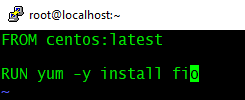Showing posts with label docker run. Show all posts
Showing posts with label docker run. Show all posts
Wednesday, December 25, 2019
Wednesday, October 23, 2019
Docker 101 - Part4 - Creating images using dockerfile
In this article, I will briefly explain how to create your own image using Dockerfile. For example, I will be creating an FIO image. FIO is a storage stress test tool and this image can be used for container storage IO benchmarking/ testing.
- Login to the CentOS docker host.
- Create a file named "Dockerfile".
- # vi Dockerfile
- Add the below two lines and save it.
- Once the build is complete, it returns the IMAGE ID as shown below.
- You can use the "docker tag" command to mention a repository and tag to the image.
- At this stage, as shown in the above screenshot, the FIO image is created with repository "vineethac/fio_image" and tagged as "latest".
- You can run this image as given below.
- # docker run -dit --name FIO_test01 --mount source=disk_data,target=/vol vineethac/fio_image fio --name=RandomReadTest1 --readwrite=randread --rwmixwrite=0 --bs=4k --invalidate=1 --direct=1 --filename=/vol/newfile --size=10g --time_based --runtime=300 --ioengine=libaio --numjobs=2 --iodepth=1 --norandommap --randrepeat=0 --exitall
- The above command will start a container with FIO application running inside it. FIO will use "/vol/newfile" for IO tests. "/vol" is using "disk_data" directory which is inside "/var/lib/docker/volumes". Once the test is complete, the container will exit.
Hope it was useful. Cheers!
Related posts
Docker 101 - Part3 - Persisting data using volumes
Docker 101 - Part2 - Basic operations
Docker 101 - Part1 - Installation
Friday, October 18, 2019
Docker 101 - Part2 - Basic operations
In this article, I will walk you through basic Docker commands and how to work with it for creating, managing, and monitoring Docker containers.
Docker version and info
#docker version
#docker info
Default directory for Docker
#cd /var/lib/docker
Pull images
#docker pull centos:latest
List images
#docker images
Create bridge network
#docker network create -d bridge --subnet 10.0.0.0/24 ps-bridge
List all bridge networks
#brctl show
Inspect a network
#docker run -dt --name centos_test --network ps-bridge centos sleep 900
SSH into a container
#docker exec -it <name> sh
List running containers
#docker ps
List all containers
#docker ps -a
List container stats
#docker stats
Stop a container
#docker stop <Container ID>
Remove a container
#docker rm <Container ID>
Remove an image
#docker rmi <REPOSITORY:TAG>
Hope it was useful. Cheers!
Related posts
References
Subscribe to:
Comments (Atom)

















